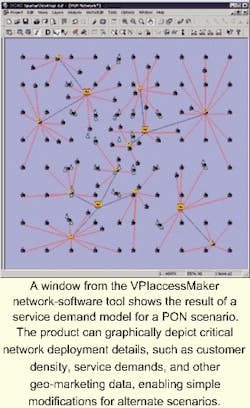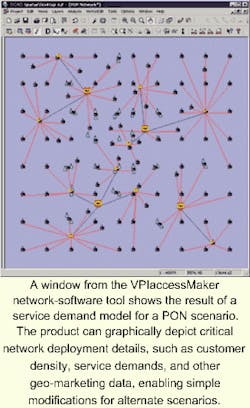Network simulation software moves to the metro
By ROBERT PEASE
TECHNOLOGYAsk almost anyone in the industry what the hottest market segment is today and it's a pretty safe bet they'll respond with "metropolitan access." A large chunk of the action in this space sought by service providers is broadband access. As new optical technology migrates into the metro area, it only makes sense for the world of network simulation to respond in kind.
Virtual Photonics Inc. (VPI-Berlin, Germany), which creates design tools for several segments of the optical-networking market, plans to be first to tap the broadband-access segment with its VPIaccessMaker. Tools such as VPIaccessMaker enable service providers to make sound strategic business decisions for broadband-access deployments rapidly. And in the fast-moving world of telecommunications, timing can be everything.
"These tools are designed to offer comprehensive techno-economic analysis by combining four functionalities," says Bernardo Henriques, vice president of VPI's broadband-access group. "They provide critical data on market demand and analysis, broadband-access architecture and technology modeling, techno-economic analysis and comparison, and a geographical-information-system (GIS) platform to put the geography into context. The result is a strategic planning tool that helps decision makers minimize risk and optimize their return on investment."Typical users of access software tools include anyone having to come to grips with the market, the money, and the technology-typically, strategic planners and analysts. It's a simplified, user-friendly way to develop business cases for upgrade strategies and "greenfield" situations, as well as for benchmarking different technologies and vendor solutions.
"Customers tell us they see multiple benefits," says Henriques. "The software improves information exchange between technical, business, and marketing units. All the automation features and algorithms save plenty of time and effort. Freedom to explore multiple scenarios minimizes risk-and all of these benefits enhance corporate understanding of key business factors."
Since strategic planning for broadcasting-access networks is highly creative and requires multiple disciplines, experience in commercial and technical aspects of the business is required. Use of the software as a data gathering and analysis tool can take a lot of legwork out of making some major network-deployment decisions. VPI has designed the system so that anyone with a knowledge of Microsoft Windows programs on a PC can learn it quickly. However, the company also offers a three-day training program.
Initially, details for the proposed service-such as traffic, usage, revenues, and growth-are input to the system. The service mix, in terms of customer type and density, geographical area, and penetration factors, is specified and entered. Even specific customer locations can be entered. Together, these entries generate a comprehensive set of geo-marketing output data, such as the required total bandwidth or the expected revenues in a particular service area.
Next, the architecture and technology module is used to model broadband-access technologies as chains of network elements, connecting links and required infrastructures. From this data, the user can configure the models to accurately represent generic or vendor-specific technologies, including fiber-to-the-curb, -building, or -home; passive optical network (PON); and hybrid fiber/coax.
"The broadband-access tool can now take all this information and generate a physical-access network design that takes into account legacy and new infrastructure," says Henriques. "The design shows how you can serve all customers with the desired mixture of services at minimum cost and maximum capacity utilization. Detailed bills of components and network costs-from investment to maintenance costs-are calculated for all years considered in the project and visually displayed on the maps or reported on spreadsheets."
Several different scenarios of a single project can be summarily compared in charts according to revenue, costs, cash flows, net present value, and internal rate of returns. Customer and service filters can be applied to select an arbitrary subset for closer investigation. A GIS platform delivers full geographical visualization in each business case.
Traditionally, access-network planning is achieved by manually designing network topologies on the maps and analyzing the capacity of the existing or new cable routes to serve the planned customer base. It's a fairly intensive spreadsheet-based task to work out all the network components necessary and then calculate all the costs of network deployment.
It becomes more problematic when several different technology scenarios must be assessed. The planning must be done from scratch for each different scenario. These processes can be repetitive, time consuming, and prone to error.
Simultaneously optimizing parameters such as cost of civil works, necessary interfaces in a network component, and customer affiliation for capacity utilization were nearly impossible tasks, says Henriques.
"When I was planning optical networks for business parks a few years ago, we used to allow one or two people up to six weeks to make three business scenarios-two weeks for the first scenario and an additional week for each alternative," says Henriques. "The same task would take a few days with a tool like VPIaccessMaker.
Even after you complete the scenarios, the customer inevitably thinks of new issues requiring you to modify the picture again and again, each time beginning from scratch. The major advantage of these software tools over traditional methods is that you're free to iterate and explore scenarios as much as you like."
A recent collaboration between VPI and Terawave Communications (Hayward, CA) put the VPIaccessMaker software to the test. Terawave enabled VPI to learn from its real-world experience with
PON technology for adaptation to its VPIaccess Maker software. Terawave used the product, along with its own TeraPON Navigator software, to model its PON solution to show customers the Terawave value proposition in various business and market cases.
"With both products, we're delivering an end-to-end software solution that enables service providers to design a network, perform a cost/benefit analysis, and develop a forecast for PON development, directly comparing alternatives like DSL (digital subscriber line)," says Sam Trotter, director of product marketing at Terawave. "The trial provided proof that oversubscribing the PON, using dynamic bandwidth allocation (DBA), was more economical and efficient than a PON without DBA functionality."
Trotter added that network design software tools are valuable to service providers, because they demonstrate the business case for technologies such as PON. Service providers can go deeper into the costs and benefits of a new networking technology with accurate modeling.
Another customer says the product was crucial in defining optimal roll-out strategies for new services and technologies, such as fiber-based broadband-access systems. Lief Ims, project director for hybrid broadband access with European network provider, Telenor, believes that in the long term, reasonable efforts spent on good planning tools are expected to be negligible compared to the investment levels and economic results involved in upgrading the last mile for future services.
"Upgrading the last mile is one of the largest challenges for telecommunications operators over the next few years- strategically, economically, technically, and in terms of operations," says Ims. "Some operators are new entrants in the access market and are likely to construct networks for both existing and future services. Incumbents like Telenor are faced with the challenge of deploying new technologies in a very cost-sensitive part of their network, primarily for future broadband services in established markets."

